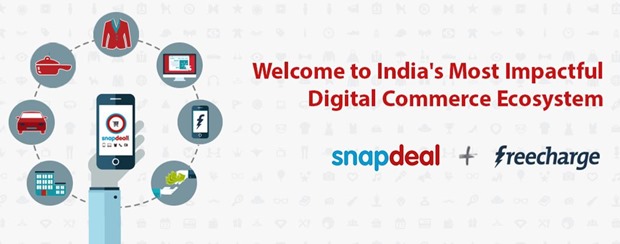3 Reasons Snapdeal Acquired Freecharge & Altered Indian mCommerce Story Forever

Even if you are living in a cave, this news must have reached you: Snapdeal acquired Freecharge for an undisclosed sum; speculations are rife that the deal is in the range of $400-450 million, with stock and equity transfers.
Last year in February, I attended an IAMAI event where Freecharge founder Kunal Shah was a panelist for a discussion regarding entrepreneurship. He had shared the challenges of building a startup and how they acquired their first 50,000 customers. For instance, they met McDonald’s management atleast 35 times before they said yes to their proposal of free coupons based on mobile recharges.
Today, after this acquisition which has been termed as one of the biggest Indian ecommerce has ever seen, SnapDeal and Freecharge together have a 40 million+ ‘customers’ and total of 30 million+ application downloads. Freecharge app alone has 10 million downloads. 1 million + daily transactions would now be handled by both of them.
This acquisition has successfully overtaken Flipkart’s acquisition of Myntra which was in the range of $350 million.
Here are three biggest reasons, based on inputs from industry watchers and Ecommerce veterans, which prompted an ecommerce marketplace to shell out close to half a billion dollars to acquire a mobile recharge company:
Mobile is the Future
In this acquisition, mobile is the most important factor..
If we try to analyze the difference between dotcom bust of 2000 and the current hyper inflated valuations of Internet companies, then we will find that mobile is the differentiator. In fact, such is the vehemence of the new mobile centric approach that Myntra has recently closed their desktop version and users can now only purchase from their mobile app!
And sceptics are terming that this is not a fad which will die down; infact usage of mobile internet is increasing at an break neck speed, and slowly almost everything would be only sold via mobiles.
In 2013, we had reported that 30% of all orders on Snapdeal originate from mobile, which increased to 60% in 2014. And as per their projections, in the next 3 years, 90% of all their orders will come only from mobile apps.
Now, let’s examine Freecharge’s business model: they enable users to recharge their ‘mobiles’ and get coupons in exchange. Considering that 100% of Freecharge’s customers are only mobile oriented, this is the best decision Snapdeal could have made. In fact, for any ecommerce company which is looking to dig deep into the mobile centric customers, Freecharge would have been the best choice.
In coming days, we can observe lots of more such acquisitions wherein ecommerce portals may acquire mobile based services.
New Customers from Tier 2 & Tier 3 Cities:
70% of all orders on Snapdeal originate from Tier 2 & Tier 3 cities, whereas only 30% of orders on Freecharge originate from these cities. If we observe this fact from the point of view of Freecharge, then getting acquired by Snapdeal made the most sense.
If Snapdeal will get benefited from Freecharge’s mobile only customers, then Freecharge will also get benefitted from Snapdeal’s Tier 2 & Tier 3 customers who are ordering products from mobile but have never used Freecharge’s platform for mobile recharges.
Freecharge can now get a big volume of new customers from these cities, who are not even aware of such excellent service. Now, how shall Freecharge compensate them with coupons is another factor all together. Maybe rural based new marketing approach would be implemented. But the point is, Freecharge will now have lots of new customers. It is estimated that 75 million mobile recharges are done every 24 hours in India, out of which only 3 million are done online.
Freecharge has positioned themselves right on track to tap this market.
Market Consolidation in eCommerce + mCommerce:
Snapdeal is India’s third biggest ecommerce portal after Flipkart and Amazon. While Flipkart is backed by Tiger Global and Naspers and other biggies, Amazon India is self-financed from Amazon headquarters in USA. This left Snapdeal to scout for investors who can fund them and believe them.
Last year, they found their big ticket investor when SoftBank infused $627 million into Snapdeal, taking its valuation more than $2 billion. Few months later, Alibaba, based by Softbank invested $575 million into PayTm, which was India’s biggest mCommerce portal before Snapdeal-Freecharge deal.
Hence, if we speak of mobile commerce landscape, then the Softbank holds the reins of Snapdeal, PayTm and Freecharge. And this proves that market consolidation is in full swing now, as it leaves three major players fighting it out for dominance: Flipkart ; Amazon and Snapdeal. Jabong & eBay remain the dark horses now, which may become crucial in shifting the pendulum of success between these big three.
Certainly, an exciting time for Indian eCommerce and mCommerce industry in India. And for Freecharge & Snapdeal, its time for celebration.

[…] boasts of 3 crore+ customers as of now, who are actively shopping on their website. Almost 60-70% of the orders received on […]
Good Acquisition but is the VALUATION justified of Rs. 2800 crore which turns out to Rs. 28000 per customer for freecharge’s customer base of 10 million. To this discount the overlap of customers between snapdeal and freecharge. At margin of 2% on GMV each customer acquired (considering all are exclusive freecharge customers) has to transact for Rs. 14 lakh which turns out to be USD 22.6 billion. So as stated by the article there are good reasons for acquisition but is the valuation justified. Deal with Alibaba has already fallen apart due to high valuation. Mohul – Please clarify if i am missing anything on the valuation justification.
[…] has acquired Freecharge for roughly $400 0 $450 million – Here are 3 compelling reasons why this acquisition made sense to both the companies and how they have altered Indian mCommerce story […]